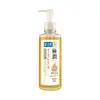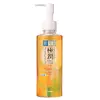What's inside
What's inside
 Key Ingredients
Key Ingredients

 Benefits
Benefits

 Concerns
Concerns

 Ingredients Side-by-side
Ingredients Side-by-side

Water
Skin ConditioningButylene Glycol
HumectantSodium Myristoyl Glutamate
CleansingSorbitol
HumectantSodium Methyl Cocoyl Taurate
CleansingSodium Lauroyl Glutamate
Cocamide DEA
EmulsifyingMyristic Acid
CleansingGlyceryl Stearate
EmollientSodium Chloride
MaskingLauric Acid
CleansingPEG-40 Hydrogenated Castor Oil
EmulsifyingPolyglyceryl-2 Isostearate
EmulsifyingPolyquaternium-7
Methylparaben
PreservativeSodium Acetylated Hyaluronate
HumectantHydroxypropyltrimonium Hyaluronate
Water, Butylene Glycol, Sodium Myristoyl Glutamate, Sorbitol, Sodium Methyl Cocoyl Taurate, Sodium Lauroyl Glutamate, Cocamide DEA, Myristic Acid, Glyceryl Stearate, Sodium Chloride, Lauric Acid, PEG-40 Hydrogenated Castor Oil, Polyglyceryl-2 Isostearate, Polyquaternium-7, Methylparaben, Sodium Acetylated Hyaluronate, Hydroxypropyltrimonium Hyaluronate
Ethylhexyl Palmitate
EmollientTriethylhexanoin
MaskingSorbeth-30 Tetraisostearate
EmulsifyingPEG-20 Glyceryl Triisostearate
EmollientOlea Europaea Fruit Oil
MaskingEthylhexyl Palmitate, Triethylhexanoin, Sorbeth-30 Tetraisostearate, PEG-20 Glyceryl Triisostearate, Olea Europaea Fruit Oil, Water, Sodium Acetylated Hyaluronate, Hydroxypropyltrimonium Hyaluronate, Simmondsia Chinensis Seed Oil, Ceresin, Dextrin Palmitate/Ethylhexanoate, Iodopropynyl Butylcarbamate, BHT
 Reviews
Reviews

Ingredients Explained
These ingredients are found in both products.
Ingredients higher up in an ingredient list are typically present in a larger amount.
This form of hyaluronic acid is produced through fermentation.
According to a manufacturer, it has a positive charge by ionic binding to help moisturize and give hair a smooth feel. This is why you'll find this ingredient in shampoos and body washes.
Sodium Acetylated Hyaluronate is a type of Hyaluronic Acid.
Hyaluronic Acids help moisturize, soothe, and protect the skin.
Read about common types of Hyaluronic Acid here:
Sodium Hyaluronate
Hydrolyzed Hyaluronic Acid
Hyaluronic Acid
Water. It's the most common cosmetic ingredient of all. You'll usually see it at the top of ingredient lists, meaning that it makes up the largest part of the product.
So why is it so popular? Water most often acts as a solvent - this means that it helps dissolve other ingredients into the formulation.
You'll also recognize water as that liquid we all need to stay alive. If you see this, drink a glass of water. Stay hydrated!
Learn more about Water